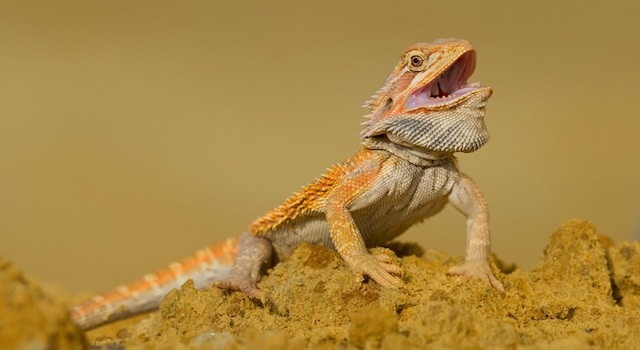
Introduction to Bearded Dragon Humidity
Although bearded dragons are native to the desert regions of Australia and have adapted to hot and dry conditions, they still need humidity to thrive. Bearded dragon humidity is important for keeping them hydrated and to facilitate healthy shedding. Bearded dragons, however, do not tolerate high levels of humidity well and can become ill if their environment is kept too damp. For this reason, it’s important to monitor the humidity levels closely and maintain them within an ideal range.
If you are unsure about the ideal bearded dragon humidity levels and how to monitor them, this article will tell you everything you need to know.
Understanding Bearded Dragon Humidity Requirements
The term “humidity” refers to the amount of water vapor in the air, and a bearded dragon’s enclosure will always have a certain level of humidity based on this. The ideal relative humidity range for bearded dragons is between 30% to 40%, similar to their native habitat’s conditions. This is ideal for both the day and night. It’s not advisable to keep the humidity levels above 50% or below 30% for too long. High humidity levels can make them more vulnerable to respiratory issues or skin infections because they haven’t adapted to damp conditions. Excess humidity can also contribute to excessive fungal and bacterial growth that could be harmful to your bearded dragon.
Signs of Incorrect Bearded Dragon Humidity Levels
Incorrect bearded dragon humidity levels can cause shedding issues, mold and bacterial growth, skin infections, and respiratory infections. Humidity that is too low or too high is equally harmful to bearded dragons. They can develop retained sheds if the humidity is too low, which occurs when parts of the shed get stuck and are difficult to remove, usually on the eyes, toes, and tail.
Very high humidity levels, usually above 50%, can also make it difficult for your bearded dragon to shed its skin properly. Various bacteria and fungi thrive in damp and humid environments, which can lead to mold and bacterial growth. This can be harmful to bearded dragons and make them susceptible to skin and respiratory infections, such as scale rot or pneumonia.
Measuring and Monitoring Bearded Dragon Humidity Levels
It’s easy to measure and monitor the humidity levels in your bearded dragon’s enclosure. Most reptile enthusiasts attach a hygrometer to the walls of the habitat to measure and monitor the humidity levels.
You can use either a digital or an analog hygrometer, although a digital one is preferred because it tends to be more accurate and reliable. Certain hygrometers include a thermometer attachment as well, so you can easily monitor the temperature and humidity levels at once.
It’s recommended to have at least two hygrometers in the habitat, ideally one in the warm zone and another in the cold zone. This allows you to effectively monitor the humidity levels throughout the enclosure and adjust the levels accordingly.
How to Lower Humidity Levels in a Bearded Dragon’s Enclosure
You can easily lower the humidity levels by allowing the enclosure to dry out, using a dehumidifier, changing the substrate, or by increasing ventilation.
Letting the enclosure dry out for a few days helps to gradually lower the humidity levels. This would mean that you should avoid misting the enclosure until the humidity levels fall within an ideal range. You generally don’t want to mist the enclosure too often if it’s causing the humidity to exceed 40% for a prolonged time. It’s better to mist the enclosure when the hygrometer measures below 30-35%, so make sure you check it throughout the day.
If you are constantly battling with high humidity issues, it’s worth considering the type of substrate you are using. Certain substrates, such as sphagnum moss and cypress mulch, are highly absorbent and can retain undesirable humidity levels. Using too much absorbent substrate in the enclosure can make it difficult to lower the humidity levels effectively. Try removing the damp substrate and replacing it with a dry, clean substrate instead.
Your bearded dragon’s enclosure should have proper ventilation to maintain good air quality and to help lower the humidity levels. Ventilation helps lower the humidity levels by bringing in fresh air from the outside to replace the stagnant, humid air inside. Their enclosure should have at least two ventilation points on either side for proper airflow.
How to Raise Humidity in a Bearded Dragon’s Enclosure
Most reptile enthusiasts use a spray bottle to mist down the enclosure and increase the humidity levels. This is done throughout the day, depending on how quickly the humidity levels decrease. In some cases, you only need to mist the enclosure every few days when the levels drop below 30%. You can also use an automatic reptile misting system to keep the humidity within an ideal range if you aren’t able to regularly use a spray bottle.
If you are struggling to keep the humidity raised and within an ideal range, you should consider making a few adjustments to the enclosure. Adding a shallow water dish near the warm end of the enclosure naturally raises the humidity.
Sphagnum moss is a great substrate that retains moisture well, so it can be used to raise humidity levels. You can soak sphagnum moss in water and place it around your bearded dragon’s enclosure. Cyprus mulch, bark, and coconut fiber are other great alternatives that retain moisture and raise humidity.
Make sure you don’t go overboard with the amount of moisture in your bearded dragon’s enclosure. The humidity levels should only be raised between 30% to 40%, and higher levels can do more harm than good.
Creating a Humid Hide for Your Bearded Dragon
Some owners like to give their bearded dragons a humid hide to help with shedding. Bearded dragons have the option to rest in the humid hide whenever they feel like it, and it functions as a controlled humid environment. Making it is relatively straightforward, and you can use a store-bought or DIY hideout. All you need to do is fill the hideout with damp sphagnum moss or coconut fiber and position it near the cooler end of the enclosure. You can maintain the humid hide by re-soaking the substrate before it dries out completely to maintain the desired humidity level.
Environmental Factors That Affect Bearded Dragon Humidity
Ambient Room Temperature
The surrounding room temperature has an impact on the humidity levels in your bearded dragon’s enclosure. If the room is warm and humid, the inside of the enclosure is likely going to be as well. Warmer temperatures increase the evaporation rate, which can dry out the enclosure quicker and lower the humidity. Whereas the relative humidity is generally higher in colder temperatures. That’s why you might find that the humidity levels fluctuate during seasonal changes, especially during the summer and winter months.
Bearded Dragon Enclosure Ventilation
It’s going to be easier to maintain optimal humidity levels in a well-ventilated enclosure with proper airflow. Proper ventilation allows excess moisture to escape and prevents excessively damp and humid conditions.
If an enclosure is fully enclosed and has poor ventilation, the air quality can become stagnant and lead to excessive moisture buildup that can be harmful to bearded dragons. However, it’s difficult to maintain ideal humidity levels if the enclosure has too much ventilation because an enclosed environment retains humidity better.
Bearded Dragon Enclosure Temperature
The temperature inside your bearded dragon’s enclosure has a significant influence on humidity. The areas with warmer temperatures, such as the basking spot, tend to have lower humidity levels than the cooler zones. The heat from the basking spot will increase evaporation and cause the surrounding area to dry out more quickly than the cold zones. This is completely normal, although it will mean that you need to mist the warmer areas more frequently to maintain an ideal 30% to 40% humidity range.
Bearded Dragon Enclosure Substrate
As previously mentioned, the substrate can influence the humidity levels and can be helpful for maintaining an ideal range. Absorbent substrates that retain moisture well will contribute to higher humidity levels. Substrates such as tiles and reptile carpets don’t hold moisture well, so you might find that the humidity levels are lower in those areas.
Tips for Maintaining Optimal Bearded Dragon Humidity
The best ways to maintain optimal humidity in your bearded dragon’s enclosure are by adjusting for seasonal changes, maintaining an ideal temperature range, and avoiding keeping the enclosure overly damp or too dry.
The humidity will fluctuate during seasonal changes, typically because it’s affected by the ambient room temperature. You probably won’t notice a difference if the room that your bearded dragon’s enclosure is kept in stays at the same temperature year-round. Otherwise, you should try adjusting the humidity levels accordingly. The enclosure tends to dry out quicker during the summer months, so try to mist it more often and use absorbent substrates. During the winter months, you want to avoid raising the humidity too high and expose your bearded dragon to cold, wet conditions.
The same applies to the warm and cold zones throughout the enclosure. It takes longer for the humidity levels to decrease in the colder zones versus in the warmer zones near the basking spot. Just make sure that you have hygrometers set up in these different areas so that you can monitor the levels and raise or lower the humidity to stay within 30% to 40%.
The Role of Humidity in Bearded Dragon Shedding
Shedding is a natural process where bearded dragons shed the outer layer of their skin and replace it with a new protective layer. If the humidity levels aren’t kept within an ideal range, it’s common for bearded dragons to experience shedding issues.
High levels of humidity can cause skin infections that can affect the shedding process. It can also make their skin very soft and mushy, making it difficult to shed properly. Low humidity can make their skin overly dry, leading to a stuck or incomplete shed. A stuck shed can be dangerous for bearded dragons if it starts cutting off blood flow to the extremities, such as their toes and tail.
They must have between 30% to 40% relative humidity to shed successfully. Many experts suggest adding a humid hide into the enclosure for bearded dragons to use while shedding. This is important if the humidity levels are too low to hydrate your bearded dragon’s skin.
Final Thoughts on Bearded Dragon Humidity
There is more to creating the ideal living environment for bearded dragons than proper temperature and UVB lighting. You must maintain the ideal humidity levels to keep them healthy and hydrated and to facilitate healthy shedding. Bearded dragons require between 30% to 40% relative humidity throughout the day and night. Humidity levels that are too low or too high can lead to health problems like stuck sheds, skin infections, or respiratory infections. You should closely monitor the humidity with a hygrometer and lower and raise it to maintain an ideal range.



